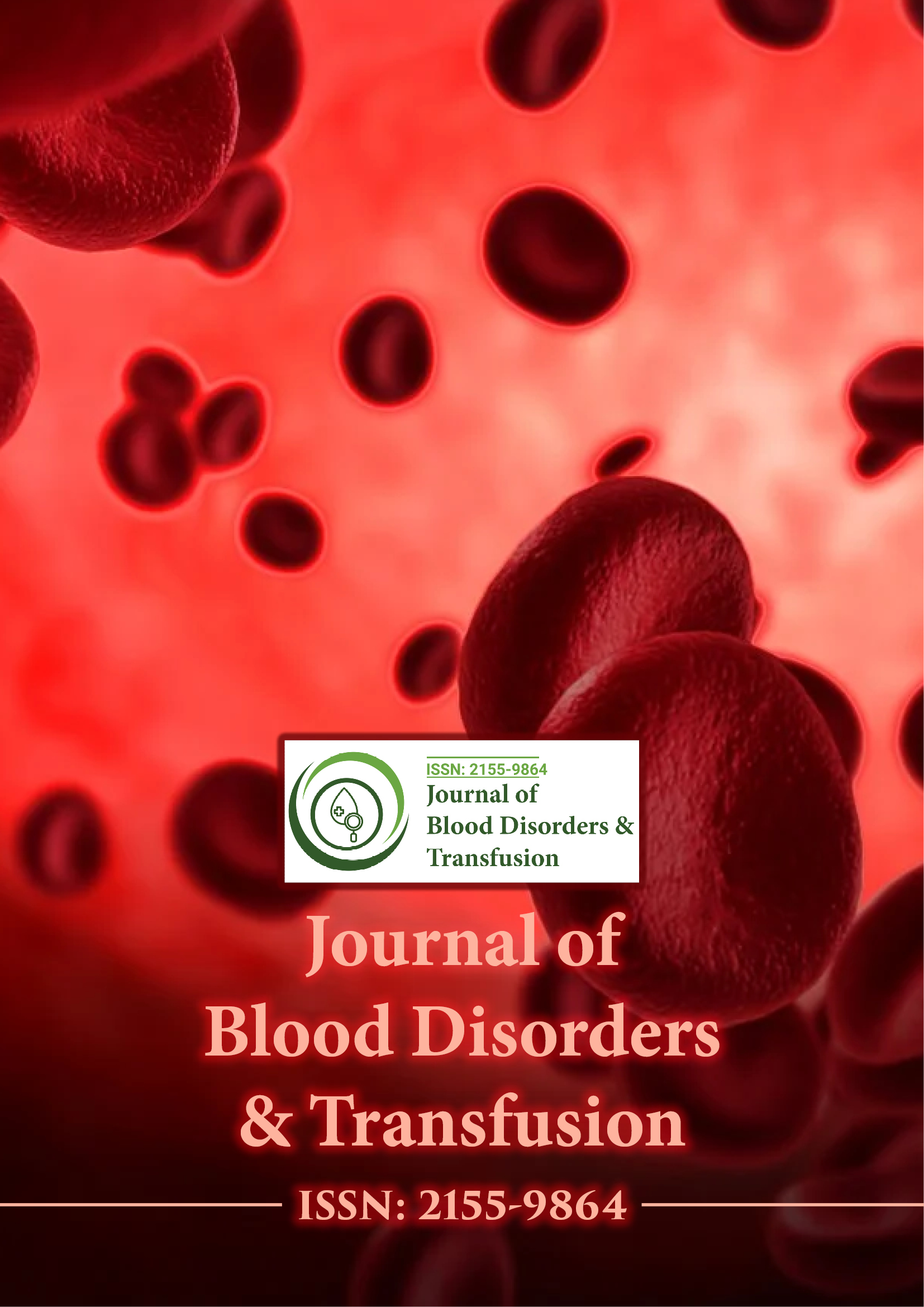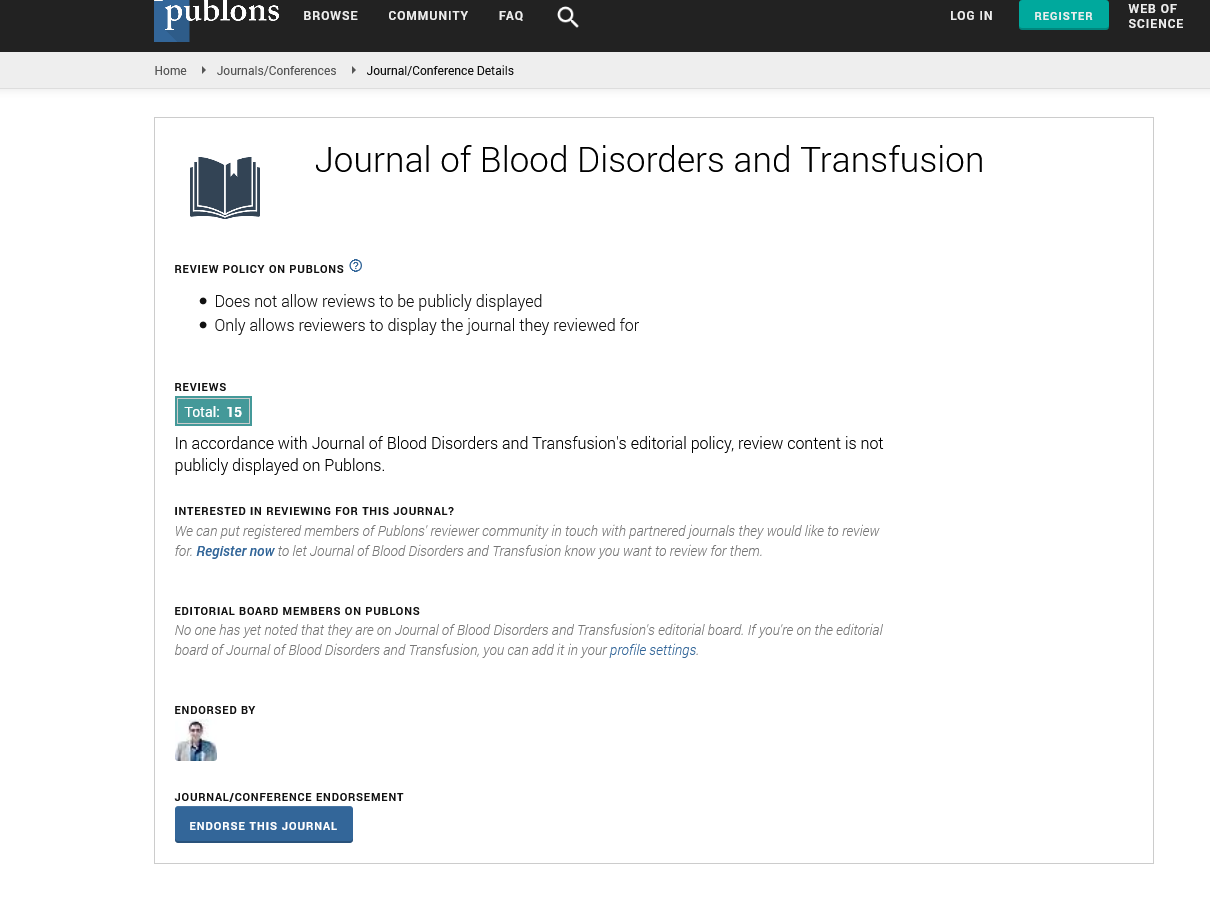Indexed In
- Open J Gate
- Genamics JournalSeek
- JournalTOCs
- Ulrich's Periodicals Directory
- RefSeek
- Hamdard University
- EBSCO A-Z
- OCLC- WorldCat
- Proquest Summons
- Publons
- Geneva Foundation for Medical Education and Research
- Euro Pub
- Google Scholar
Useful Links
Share This Page
Journal Flyer

Open Access Journals
- Agri and Aquaculture
- Biochemistry
- Bioinformatics & Systems Biology
- Business & Management
- Chemistry
- Clinical Sciences
- Engineering
- Food & Nutrition
- General Science
- Genetics & Molecular Biology
- Immunology & Microbiology
- Medical Sciences
- Neuroscience & Psychology
- Nursing & Health Care
- Pharmaceutical Sciences
Opinion Article - (2025) Volume 16, Issue 2
Platelet Dysfunction and Bleeding in Myeloproliferative Neoplasms
Aric Wiechert*Received: 25-Feb-2025, Manuscript No. JBDT-25-28786 ; Editor assigned: 27-Feb-2025, Pre QC No. JBDT-25-28786 (PQ); Reviewed: 13-Mar-2025, QC No. JBDT-25-28786 ; Revised: 20-Mar-2025, Manuscript No. JBDT-25-28786 (R); Published: 27-Mar-2025, DOI: 10.4172/2155-9864.25.16.617
Description
Essential Thrombocythemia (ET) is a chronic myeloproliferative neoplasm characterized by a persistent increase in platelet count. While it is typically associated with an elevated risk of thrombosis, paradoxically, patients with ET — particularly those with extreme thrombocytosis — are also susceptible to bleeding complications. The dichotomy between thrombotic and hemorrhagic manifestations presents a significant challenge in clinical management, requiring a careful assessment of individual risk profiles and therapeutic strategies.
Pathophysiology of bleeding
In ET, megakaryocytic hyperplasia in the bone marrow leads to overproduction of platelets. However, despite the elevated platelet count, qualitative defects are frequently present. These defects affect aggregation, secretion and adhesion functions. Furthermore, patients may exhibit an acquired form of Von Willebrand Disease (VWD), which significantly contributes to bleeding. This condition arises when high circulating platelet numbers lead to adsorption and proteolytic degradation of Von Willebrand Factor (VWF), impairing its function in primary hemostasis.
The bleeding risk in ET is not uniformly distributed across all patients. It tends to be higher in those with extremely elevated platelet counts. At such levels, the degradation and clearance of VWF become more pronounced, diminishing its hemostatic efficacy. As a result, mucocutaneous bleeding, epistaxis, gastrointestinal hemorrhage and menorrhagia are frequently observed in this subgroup.
Extreme thrombocytosis and bleeding
The presence of extreme thrombocytosis has traditionally raised concern for thrombotic events. However, it is now well-recognized that platelet counts often correlate more with hemorrhagic than thrombotic events. This paradox stems largely from the aforementioned acquired VWD and platelet dysfunction, both of which compromise clot formation despite a seemingly adequate or excessive number of circulating platelets.
Clinical observations have supported this understanding. Studies indicate that patients with platelet counts surpassing have a markedly increased incidence of bleeding. In fact, bleeding complications in ET are often underestimated due to the greater focus historically placed on thrombosis. Nonetheless, these hemorrhagic events can be just as serious, leading to morbidity and occasionally, mortality.
Clinical presentation of bleeding in ET
Bleeding manifestations in ET typically involve mucocutaneous sites. The most common symptoms include easy bruising, prolonged bleeding after minor cuts and spontaneous nosebleeds. Gastrointestinal bleeding, although less frequent, can be severe and requires prompt evaluation. Hematuria and heavy menstrual bleeding are also reported.
Intracranial or intramuscular hemorrhages are rare but can occur, particularly in the setting of very high platelet counts and concurrent anticoagulation or antiplatelet therapy. Bleeding may also present following surgical or dental procedures, emphasizing the need for pre-operative hematological assessment in known or suspected ET cases.
Diagnosis and monitoring
The diagnosis of bleeding risk in ET involves not only routine blood counts but also functional assays of platelet activity and VWF parameters. Platelet aggregation studies can help identify functional defects, though they are not widely available. Measurement of VWF antigen and activity, along with multimeric analysis, is more commonly used to detect acquired VWD.
Prognostic implications
The bleeding risk in ET, though significant, does not necessarily indicate a worse prognosis when appropriately managed. However, unrecognized or inadequately treated bleeding episodes can lead to complications that impair quality of life. Patients with frequent or severe bleeding may require more aggressive management and closer monitoring.
Additionally, bleeding complications may affect treatment decisions and limit the use of certain therapies. For instance, the presence of bleeding may preclude the use of antiplatelet agents, which are otherwise beneficial in reducing thrombosis risk. Therefore, a comprehensive risk assessment incorporating both thrombotic and hemorrhagic risks is essential in guiding therapy.
Citation: Wiechert A (2025). Platelet Dysfunction and Bleeding in Myeloproliferative Neoplasms. J Blood Disord Transfus. 16:617.
Copyright: © 2025 Wiechert A. This is an open-access article distributed under the terms of the Creative Commons Attribution License, which permits unrestricted use, distribution, and reproduction in any medium, provided the original author and source are credited

